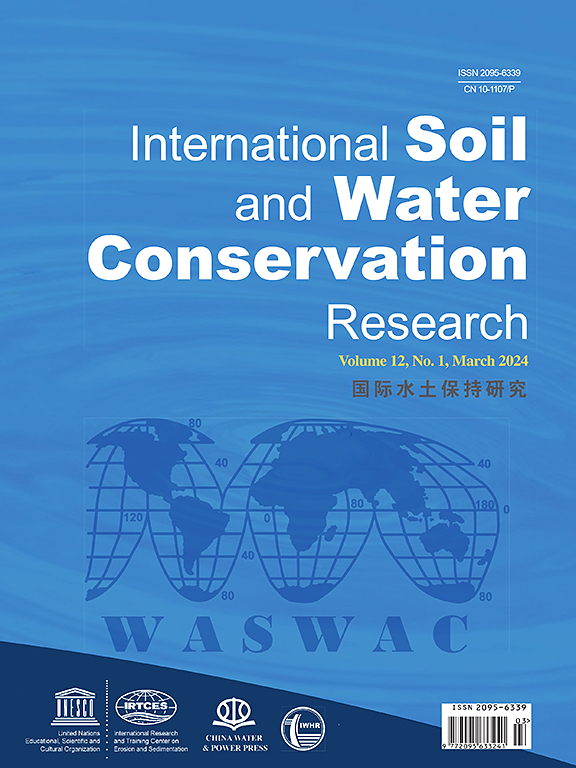利用SBAS-InSAR技术监测咸海南部风蚀
IF 7.3
1区 农林科学
Q1 ENVIRONMENTAL SCIENCES
International Soil and Water Conservation Research
Pub Date : 2025-05-16
DOI:10.1016/j.iswcr.2025.05.005
引用次数: 0
摘要
由于咸海自1960年代以来大量减少而产生的咸海沙漠被认为是造成中亚盐尘风暴的主要因素。本研究利用SBAS-InSAR技术对阿拉尔库姆沙漠南部地区的地面风蚀变形进行了监测,分析了风沙沉降和堆积情况。利用Geodetector模型进一步分析了风蚀对各种影响因素的敏感性。结果表明,风蚀强度与暴露时间呈负相关。东叶和西叶的海岸线正在经历最严重的侵蚀,地面沉降超过20mm yr - 1。沙流活动具有季节性,以春季的绝对变形最为显著。土壤湿度是控制地表变形的主要因素,风速是导致地表变形的主要因素。根据地面变形时间序列,咸海盆地可分为快速侵蚀带、缓慢侵蚀带、稳定带、缓慢沉积带和快速沉积带。最后,利用2020年3月22日的一次强烈沙尘事件来验证SBAS-InSAR技术的结果。与以往的研究不同,本研究提供了更详细的风吹沉积物沉降和堆积的观点,超越了干燥咸海盆地作为粉尘排放源的简单概念。这些发现为定量估计咸海南部盆地的粉尘排放提供了重要的见解。本文章由计算机程序翻译,如有差异,请以英文原文为准。

Monitoring of wind erosion in the southern Aral Sea using SBAS-InSAR technology
The Aralkum Desert, arising from the significant reduction of the Aral Sea since the 1960s, is recognized as a prominent contributor to salt-dust storms in Central Asia. This study used SBAS-InSAR technology to monitor ground deformation from wind erosion in the southern Aralkum Desert, analyzing wind-blown sediment subsidence and accumulation. The sensitivity of wind erosion to various influencing factors was further analyzed using the Geodetector model. Results indicate a negative correlation between wind erosion intensity and exposure time. The coastlines of the eastern and western lobes are experiencing the most severe erosion, with ground settlement exceeding 20 mm yr−1. Sand-drift activities exhibit a seasonal pattern, with spring experiencing the most notable absolute deformation. Soil moisture was identified as the primary factor controlling ground deformation, while wind speed was the essential factor leading to the deformation. Based on the time series of ground deformation, the dried Aral Sea basin can be clustered into rapid erosion, slow erosion, stable, slow deposit, and rapid deposit zones, respectively. Finally, an intense dust event on March 22, 2020, was used to verify the results derived from the SBAS-InSAR technology. Different from the previous studies, this research provides a more detailed view of wind-blown sediment subsidence and accumulation, moving beyond the concept of the dried Aral Sea basin as a simple source of dust emissions. These findings offer vital insights for the quantitative estimation of dust emissions in the southern Aral Sea basin.
求助全文
通过发布文献求助,成功后即可免费获取论文全文。
去求助
来源期刊

International Soil and Water Conservation Research
Agricultural and Biological Sciences-Agronomy and Crop Science
CiteScore
12.00
自引率
3.10%
发文量
171
审稿时长
49 days
期刊介绍:
The International Soil and Water Conservation Research (ISWCR), the official journal of World Association of Soil and Water Conservation (WASWAC) http://www.waswac.org, is a multidisciplinary journal of soil and water conservation research, practice, policy, and perspectives. It aims to disseminate new knowledge and promote the practice of soil and water conservation.
The scope of International Soil and Water Conservation Research includes research, strategies, and technologies for prediction, prevention, and protection of soil and water resources. It deals with identification, characterization, and modeling; dynamic monitoring and evaluation; assessment and management of conservation practice and creation and implementation of quality standards.
Examples of appropriate topical areas include (but are not limited to):
• Conservation models, tools, and technologies
• Conservation agricultural
• Soil health resources, indicators, assessment, and management
• Land degradation
• Sustainable development
• Soil erosion and its control
• Soil erosion processes
• Water resources assessment and management
• Watershed management
• Soil erosion models
• Literature review on topics related soil and water conservation research
 求助内容:
求助内容: 应助结果提醒方式:
应助结果提醒方式:


